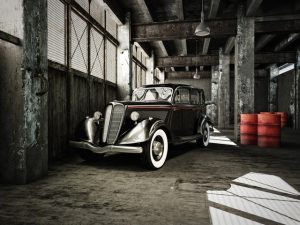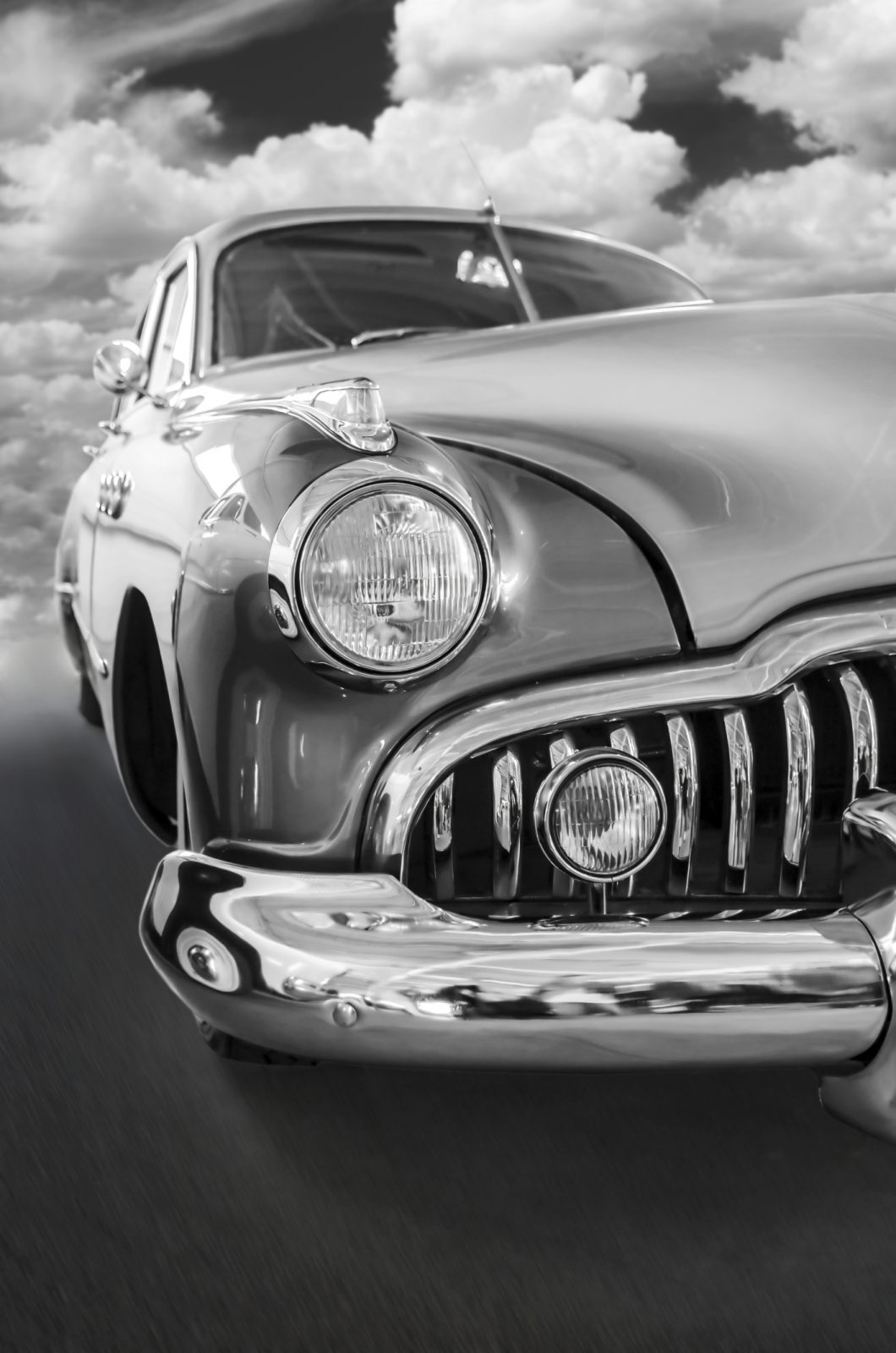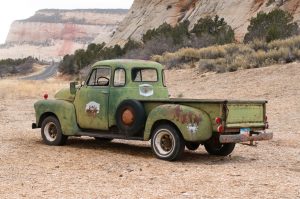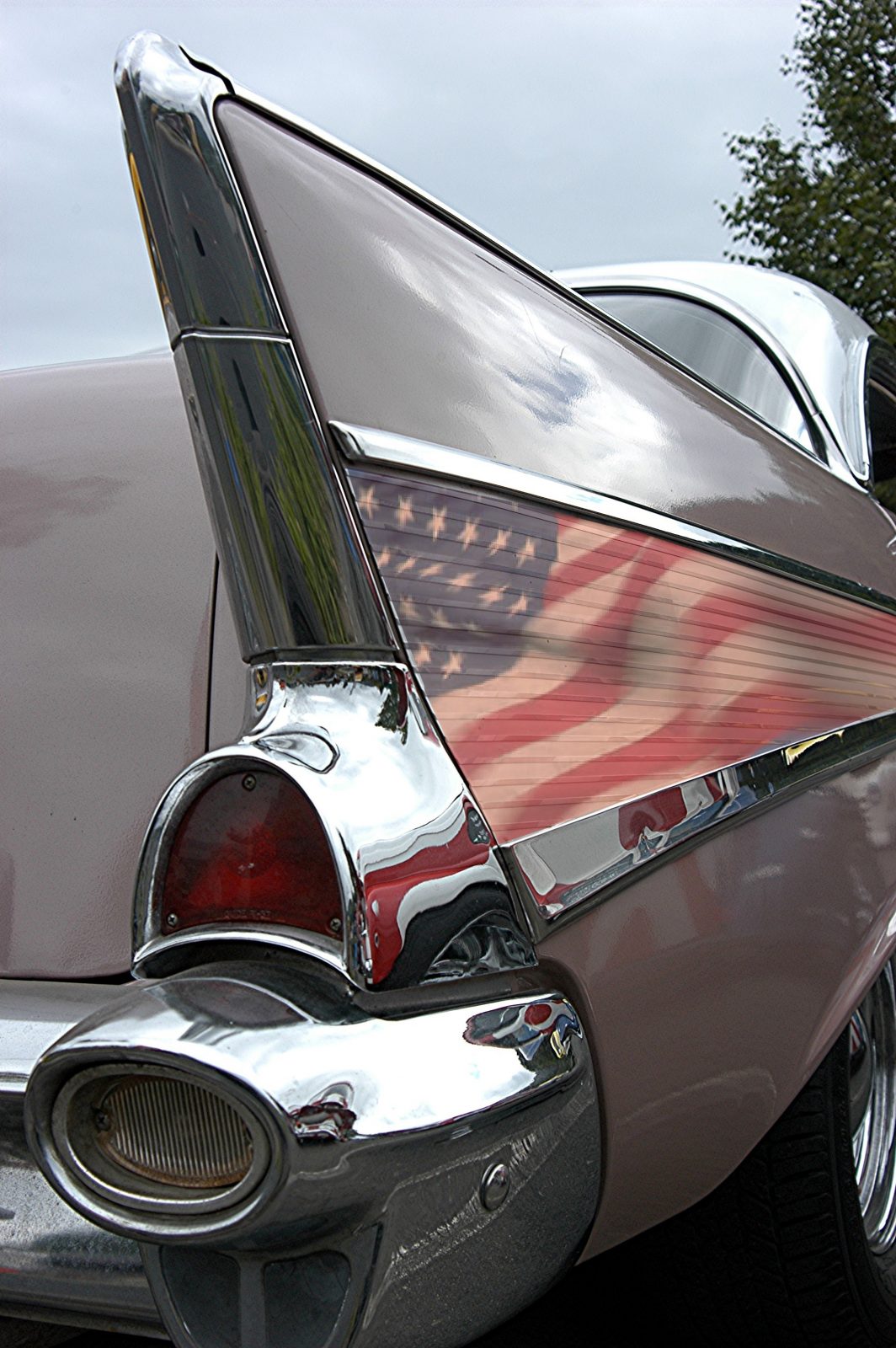5 Tips for Taking Spectacular Photos of Your Classic Car
For best results in classic car pictures, photographers consider locations, camera angles, lighting, details, and car show conditions.
Location
 Good photographers select scenic environments. Nothing spoils a classic car picture worse than an unsightly setting. It is difficult to appreciate the beauty of automotive tyling in the midst of messy clutter. Locations should enhance the appearance of the car, not distract from it, and even the most visually impressive vehicle can become inconspicuous in a busy street, or flamboyant buildings can become unintended focal points that make cars more like sidelights than centerpieces. Backgrounds always should complement the car rather than compete with it for viewer attention. Quaint, quiet streets, open fields, and stone or brick walls are good backgrounds, but reflections of surrounding objects on a car’s shiny paint should be avoided. In landscapes are overly lovely to look at, the photo should crop in close to the car so the surrounding view does not dominate the content unduly.
Good photographers select scenic environments. Nothing spoils a classic car picture worse than an unsightly setting. It is difficult to appreciate the beauty of automotive tyling in the midst of messy clutter. Locations should enhance the appearance of the car, not distract from it, and even the most visually impressive vehicle can become inconspicuous in a busy street, or flamboyant buildings can become unintended focal points that make cars more like sidelights than centerpieces. Backgrounds always should complement the car rather than compete with it for viewer attention. Quaint, quiet streets, open fields, and stone or brick walls are good backgrounds, but reflections of surrounding objects on a car’s shiny paint should be avoided. In landscapes are overly lovely to look at, the photo should crop in close to the car so the surrounding view does not dominate the content unduly.
In normal everyday life, the car might be on the road, in a car park, or on its driveway, plain settings that provide little visual appeal. For a gritty feel or moody atmosphere, an industrial part of town among warehouses or the top level of a car park with views across the city might be suitable. For a clean, upper-class image, a city business district with blocks of modern architecture with reflective glass would make sense. For country color, the crest of a hill overlooking a landscape with the sun setting in the background would be hard to beat. Great locations increase artistic opportunities.
In abnormal settings, the photographer should consider carefully whether the photo might make the car look out of place if parked on grass, for example. There is no need for overly adventurous location selections that take the car too far from normal context.
Angles and Perspectives
 In average snapshots of collector cars, they fit the frames. Creative photographers use angles to produce portraits rather than snapshots. Turned wheels can add an item of interest and dimension to a photo. Interesting aspects can be found in details like alloy wheels, fancy shifters and pedals, and leather stitching. The exterior of a Corvette is a familiar sight to most people, but not everyone has sat in one and looked over the details a photo can show them. Many professional photographers use wide-angle lenses for car subjects to add dimension and a creative flair. Either external wide-angle lens accessories or panoramic photographic applications can perform this function well.
In average snapshots of collector cars, they fit the frames. Creative photographers use angles to produce portraits rather than snapshots. Turned wheels can add an item of interest and dimension to a photo. Interesting aspects can be found in details like alloy wheels, fancy shifters and pedals, and leather stitching. The exterior of a Corvette is a familiar sight to most people, but not everyone has sat in one and looked over the details a photo can show them. Many professional photographers use wide-angle lenses for car subjects to add dimension and a creative flair. Either external wide-angle lens accessories or panoramic photographic applications can perform this function well.
Professional cameras and special lenses certainly have their uses, but ordinary digital and even phone cameras are capable of amazing images. Headlight-level angles from kneeing positions popular with professional photographers give the car an aggressive appearance as its own body shields potentially distracting background objects from view. A bird’s-eye view from a high point like a second-story window is a good perspective for showcasing hood art or full-body paint jobs. A camera tilt to show the car diagonally across the frame can suggest motion as if it’s on its way out of the photo. A camera set on the ground can add an interesting foreground dimension.
Viewers like to see collector cars from various vantage points as the photographer walks around them taking pictures on the way. This technique is impressive with paint jobs that seem to change color with the perspective. Moving or re-positioning the car against the background adds to the variation. Ramps and jack stands show off suspensions and undercarriages. Front and rear three-quarter shots from kneeling or sitting positions in which the photographer can see all four wheels are traditional classic car pictures that seldom fail to please.
Lighting
 Lighting is an essential element of every classic car picture. Depending on location and timing, natural light during the hours just before and during sunrise and through sunset is best for lovely, warm sunlight on the subject and no harsh brightness to cause problems with reflections. And there is always the option of artificial lighting, to which some have more access than do others. For best results, there are no necessarily right and wrong ways to illuminate classic cars, but one proven method is to set up lights or flashguns one by one to highlight aspects or angles of the car, take a test shot or two, and then set up another so as not to light the car too much with light sources doubling up on lighted areas. Lighting is a very individual preference that can define the personal style and mood of the shot according to the preferences of the photographer.
Lighting is an essential element of every classic car picture. Depending on location and timing, natural light during the hours just before and during sunrise and through sunset is best for lovely, warm sunlight on the subject and no harsh brightness to cause problems with reflections. And there is always the option of artificial lighting, to which some have more access than do others. For best results, there are no necessarily right and wrong ways to illuminate classic cars, but one proven method is to set up lights or flashguns one by one to highlight aspects or angles of the car, take a test shot or two, and then set up another so as not to light the car too much with light sources doubling up on lighted areas. Lighting is a very individual preference that can define the personal style and mood of the shot according to the preferences of the photographer.
The best time for outdoor photography is not when the sun is at its highest and brightest. The camera can’t capture as much of the optical spectrum as can the eye so photos have too much contrast. Shadows look black and bright spots blinding. Shiny paint reflects sky and clouds more easily than it does at other times, making those reflective areas significantly brighter than other parts of the car. The best time for outdoor photos of classic cars is when the sun is low in the sky and produces warm tones of light in a narrow dynamic range in which the camera can capture an image closely matching what the eyes see.
An alternative to an outdoor or location shot is a studio. Renting a studio large enough for classic cars is expensive, so a large garage with white walls may be a workable alternative to expensive studio space. An advantage of a studio is the ability to control lighting creatively for interior and detail shots, but full-car photos can look bland with no context. Finally, when considering location, the photographer should consider carefully how the surroundings relate to the color of the car and whether the tones complement or clash with each other.
Details
 Car details can be photographic highlights. Certain collector cars have famous features like distinctive body shapes and styles, badges, gauge and instrument clusters, grilles, lights, or wheels for main focus. Customized features give cars individual identities to capture from various angles. Engine shots can interest viewers if customized to stand apart from other car engines.
Car details can be photographic highlights. Certain collector cars have famous features like distinctive body shapes and styles, badges, gauge and instrument clusters, grilles, lights, or wheels for main focus. Customized features give cars individual identities to capture from various angles. Engine shots can interest viewers if customized to stand apart from other car engines.
Many interesting interior details are worth shooting. Manufacturer logos appear many times in car interiors, and a few nice design features may be worth consideration. Enough light must be available for photos on location in the evening so as not to miss details that could be enhanced with studio lights.
Of course, the car should be clean. Any amount of dirt on it will tend to be conspicuous, so it should have a good washing and waxing beforehand. If the photo is in a remote location, the photographer should wash it there to remove any uncleanliness accumulated en route.
Car Shows
At classic car shows, the photographer should bear in mind that a raised hood breaks up a car’s body lines. If the owner is nearby, the photographer can request a closed hood for a better photograph, offering a print or a digital file for the favor. It’s also a good idea to remove show placards, another favor the owner can do for the photographer. When photographing classis cars late in the day, ask owners for permission to turn on the parking lights for warm subtle glows from front, sides, and rear.





